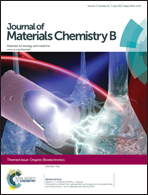Two dimensional nanosheets as conductive, flexible elements in biomaterials
Abstract
Since the discovery of graphene in 2004, two-dimensional (2D) nanostructures have been attracting tremendous interest for a variety of applications, including bio-inspired applications, due to their fascinating electronic, mechanical and optical properties. Especially, graphene and other 2D or quasi-2D nanostructures show excellent conductivity and flexibility. Herein, we highlight the recent impressive progress concerning the use of two representative types of 2D and quasi-2D nanostructures, graphene-based nanosheets and ultrathin polymeric nanosheets, as conductive or/and flexible elements to engineer three dimensional (3D) tissues. The results feature the unique potential of these 2D and quasi-2D nanostructures in the biomaterial tissue engineering research field.

- This article is part of the themed collection: Bioelectronics

 Please wait while we load your content...
Please wait while we load your content...